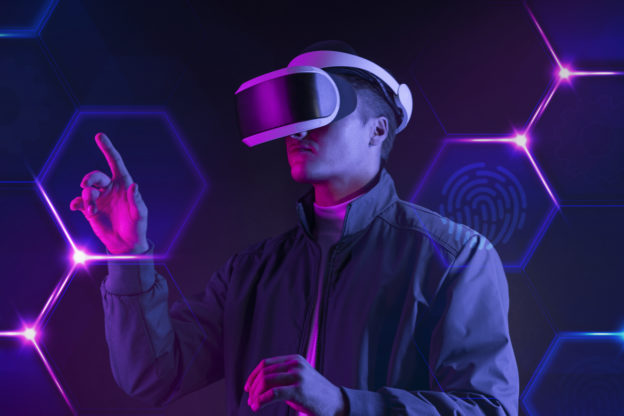
Metaverse means to enhance various functional services through immersive interaction, real simulation and other elements, including virtual meetings, digital simulation analysis, virtual communities, game entertainment and creation, etc., which have become the main applications of the early development. According to TrendForce, in order to build a more complex meta-universe than the Internet world, it will require a more powerful data computing core, a low-latency network environment for transmitting huge data, and AR /VR devices, with better display effects on the client side. Will further drive the development of memory demand, advanced wafer manufacturing, 5G network communications, and display technology.
In terms of memory, the conceptual framework of Metaverse relies more on the support of endpoint computing. It is expected to give data centers more activation factors, drive the growth of micro-servers and edge computing, and it is expected to drive the growth of DRAM in stand-alone capacity demand, and With the simultaneous improvement of storage hardware performance, the high-speed writing characteristics of SSD and HDD will be a necessary choice. Take VR devices as an example. Currently, most of them are equipped with 4GB LPDRAM with low power consumption and high performance. In the short term, since the corresponding AP does not have a plan to greatly increase the specifications, and the processing situation is simple, so It appears to be stable on the increase in capacity. In terms of storage, the related AR/VR devices are mostly equipped with Qualcomm chips and follow the specifications of the flagship SoC of smart phones, so the starting point is to carry UFS 3.1.
Advanced process, due to import and enhance the computing needs of the AI, high-speed computing chip become one of the key roles, let illustrated imaging and processing large amounts of data can be more smooth, more advanced manufacturing process will provide the size, performance and Power-saving computing chips will have good performance. The realization of Metaverse requires high-speed computing chips and image processing chips, so CPUs and GPUs with strong computing capabilities are the core roles. According to TrendForce, in terms of CPU, the current mainstream products of Intel and AMD fall on the Intel 7 (approximately equivalent to 10nm) and TSMC 7nm process, respectively. In 2022, there are plans to adopt TSMC 3nm and 5nm respectively. In terms of GPU, AMD's projection plan is almost synchronized with CPU products; NVIDIA currently adopts 7nm and 8nm processes in TSMC and Samsung respectively. At the same time, there is already a 5nm process plan, which is expected to come out in early 2023.
In terms of network communications, since Metaverse emphasizes real-time, realistic and stable virtual interactions, the bandwidth and latency of data transmission will be paid more attention to. This demand meets the three major characteristics of 5G high-frequency bandwidth, low latency, and wide connectivity, and is expected to drive The commercialization of 5G-related technologies is accelerating, such as independent networking (SA) multi-slicing that can maintain network flexibility, multi-access edge computing (MEC) that increases computing power, and integration of time-sensitive networks (TSN) to improve reliability and even integration Wi-Fi 6 extends the range of indoor communication, etc., which will become an important foundation for the future construction of a meta-universe network environment and an important main axis for the development of network services in recent years.
In terms of display technology, the immersiveness of VR/ AR devices comes from the pursuit of higher resolution and refresh rate, especially the improvement of resolution. Under the trend of display shrinking, Micro LED and Micro OLED are bound to be more valued; while the traditional 60Hz It has been unable to meet the presentation of advanced display effects, and it is expected that specifications above 120Hz will leap into the mainstream in the future. As for interactivity, the display design that does not stick to the traditional style is emphasized. The market demand for flexible and flexible displays advertised as Free Form Factor will be to treat everyone or everything equally favorably. At the same time, it will also be conducive to the development of transparent display technology that emphasizes penetration. Under the concept of meta-universe, it will become an important interface between virtual and reality.
In terms of memory, the conceptual framework of Metaverse relies more on the support of endpoint computing. It is expected to give data centers more activation factors, drive the growth of micro-servers and edge computing, and it is expected to drive the growth of DRAM in stand-alone capacity demand, and With the simultaneous improvement of storage hardware performance, the high-speed writing characteristics of SSD and HDD will be a necessary choice. Take VR devices as an example. Currently, most of them are equipped with 4GB LPDRAM with low power consumption and high performance. In the short term, since the corresponding AP does not have a plan to greatly increase the specifications, and the processing situation is simple, so It appears to be stable on the increase in capacity. In terms of storage, the related AR/VR devices are mostly equipped with Qualcomm chips and follow the specifications of the flagship SoC of smart phones, so the starting point is to carry UFS 3.1.
Advanced process, due to import and enhance the computing needs of the AI, high-speed computing chip become one of the key roles, let illustrated imaging and processing large amounts of data can be more smooth, more advanced manufacturing process will provide the size, performance and Power-saving computing chips will have good performance. The realization of Metaverse requires high-speed computing chips and image processing chips, so CPUs and GPUs with strong computing capabilities are the core roles. According to TrendForce, in terms of CPU, the current mainstream products of Intel and AMD fall on the Intel 7 (approximately equivalent to 10nm) and TSMC 7nm process, respectively. In 2022, there are plans to adopt TSMC 3nm and 5nm respectively. In terms of GPU, AMD's projection plan is almost synchronized with CPU products; NVIDIA currently adopts 7nm and 8nm processes in TSMC and Samsung respectively. At the same time, there is already a 5nm process plan, which is expected to come out in early 2023.
In terms of network communications, since Metaverse emphasizes real-time, realistic and stable virtual interactions, the bandwidth and latency of data transmission will be paid more attention to. This demand meets the three major characteristics of 5G high-frequency bandwidth, low latency, and wide connectivity, and is expected to drive The commercialization of 5G-related technologies is accelerating, such as independent networking (SA) multi-slicing that can maintain network flexibility, multi-access edge computing (MEC) that increases computing power, and integration of time-sensitive networks (TSN) to improve reliability and even integration Wi-Fi 6 extends the range of indoor communication, etc., which will become an important foundation for the future construction of a meta-universe network environment and an important main axis for the development of network services in recent years.
In terms of display technology, the immersiveness of VR/ AR devices comes from the pursuit of higher resolution and refresh rate, especially the improvement of resolution. Under the trend of display shrinking, Micro LED and Micro OLED are bound to be more valued; while the traditional 60Hz It has been unable to meet the presentation of advanced display effects, and it is expected that specifications above 120Hz will leap into the mainstream in the future. As for interactivity, the display design that does not stick to the traditional style is emphasized. The market demand for flexible and flexible displays advertised as Free Form Factor will be to treat everyone or everything equally favorably. At the same time, it will also be conducive to the development of transparent display technology that emphasizes penetration. Under the concept of meta-universe, it will become an important interface between virtual and reality.
Article source/URL: TechNews/reporter: TechNews: https://udn.com/news/story/7240/5892356
Source of the firsr image: Technology photo created by rawpixel.com – www.freepik.com
PRECITECH TAYOR HOBSON YAGISHITA GIKEN



